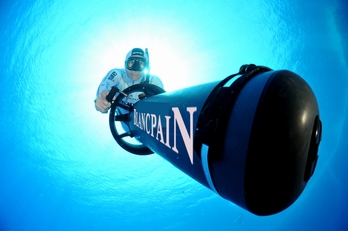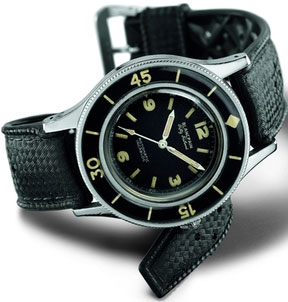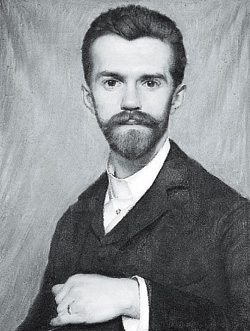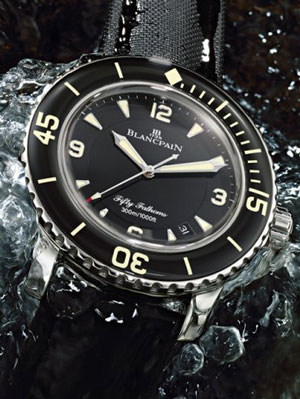Religion of Time and watch idols. Cult watch “Fifty Fathoms” – Blancpain (Part 2)
Divers: the researchers of underwater
Diving is one of the most dangerous professions,.jpg) which is a leader in mortality. The first records of diving into the water belong to antiquity. Roman naturalist Pliny, telling about ancient divers in his writings, notes their swiftness and dexterity, comparing them with marine animals. which is a leader in mortality. The first records of diving into the water belong to antiquity. Roman naturalist Pliny, telling about ancient divers in his writings, notes their swiftness and dexterity, comparing them with marine animals.
The concept of military diver, as such, appeared during the naval war between the Persians and the Greeks (in 480), after which the divers were actively used during various combat operations... Over time, various devices that 'helped' swimmers under water appeared, despite the fact that in medieval Europe, for example, a study of underwater depth could easily lead to committing to the flames. Nevertheless, the studies were carried out continuously, and one of those who made a significant contribution to the study of underwater depth, was Leonardo da Vinci...
The twentieth century became a new era for divers. Local and full-scale wars, sadly, became a huge impetus to the development of diving equipment, and consequently, to the development of underwater research and all kinds of work. Military swimmers played a significant role during World War II. The Italians were the first, who used the experience of military swimmers, in  September of 1941. Two years later, in May of 1942, in America, the first specialized unit of military swimmers was formed, and by the end of the war the number of such troops was already more than three thousand swimmers and about 34 units for special purposes. The home base of "military divers" was in Hawaii (on Maui), about which nothing is practically known... September of 1941. Two years later, in May of 1942, in America, the first specialized unit of military swimmers was formed, and by the end of the war the number of such troops was already more than three thousand swimmers and about 34 units for special purposes. The home base of "military divers" was in Hawaii (on Maui), about which nothing is practically known...
Nevertheless, despite high prevalence and recognition of professional divers, this profession is quite vaguely known in detail. As experts often note, the water, in fact, is not so safe. It is a very hostile and dangerous environment, in which the divers have to spend a lot of time, experiencing a lot of stress and risk. That’s why the profession of diver is considered to be one of the hardest jobs with particularly hazardous and exploitative conditions. The divers, depending on the depth at which they work, need special equipment and... watches, of course! Special watches for diving.
Today, a special underwater watch is not a surprise. Various companies offer a wide range of products, including models with different immersion marking, made of different materials, with huge variety of functions and complications, and design – everyone can make his choice. However, no matter how diverse the choice of modern deep-water watches is, the mother of all deep-water models can certainly be called the cult watch “Fifty Fathoms” of the watch company “Blancpain” - the most powerful symbol of communication between man, sea and watch...
Cult watch “Fifty Fathoms” - a symbol of connection between Blancpain and the world of sea
First “Fifty Fathoms” comes to the French market in 1954, becoming an indispensable and reliable assistant for people, whose profession is related to the underwater world. The appearance of this model on the watch market meant a new round of development in watchmaking, a new era in the design of watches to be used at depth, new standards and a new level in creation of deep-water watches - the most real cult watch! an indispensable and reliable assistant for people, whose profession is related to the underwater world. The appearance of this model on the watch market meant a new round of development in watchmaking, a new era in the design of watches to be used at depth, new standards and a new level in creation of deep-water watches - the most real cult watch!
The history of cult watch “Blancpain Fifty Fathoms” begins in 1952. Originally “Fifty Fathoms”, designed for the French army divers, became one of the most important events in the watch world of its time.
Uncompromisingly sporty character, premium craftsmanship, innovative materials, elegance and strength of structure, outstanding technical features - the legendary watch “Fifty Fathoms”, gaining the status of cult watch, underwent with honor any extreme situations for a long time, confirming its exceptional quality and originality.
This watch is a complicated time meter with the legendary spirit of the age and experience of the craftsmen, who created the watch that is not afraid of any tests. “Fifty Fathoms” is designed for active people with active lifestyle, for those, who need a watch that will not fail under any circumstances!
Today the descendant watch of the legendary model is water-resistant at 1000 meters. It has become much "enduring" and more original in design execution. However, the very first model has remained in history as one of the most exclusive products of its time, the story of creation of which has become one of the brightest pages in the history of watchmaking...
Fifty Fathoms
(1).jpg) In 1952, the French Ministry of Defense charged two Marine officers - Lieutenant Claude Riffaud and Captain Bob (Robert) Maloubier – with creation of an elite unit of submariners – “Les Nageurs de Combat”. They started a strict selection: the best swimmers of the commandos were selected for the unit. The swimmers needed special equipment, which also included deep-water watches. For the production of diving watches, the officers addressed to the French company “Lip”, located in Besançon and being the state monopoly in the manufacture of watches at that time. However, the craftsmen of the company did not take the order, finding it too difficult, and sent the officers to “Blancpain”, which at that time was called “Blancpain-Rayville”. The company “Blancpain” didn’t have the best time those years: the sudden death of owner and CEO Frederic-Emile in 1932 completely "decapitated" the company, breaking off the dynasty of famous and talented watchmakers Blancpain. In 1952, the French Ministry of Defense charged two Marine officers - Lieutenant Claude Riffaud and Captain Bob (Robert) Maloubier – with creation of an elite unit of submariners – “Les Nageurs de Combat”. They started a strict selection: the best swimmers of the commandos were selected for the unit. The swimmers needed special equipment, which also included deep-water watches. For the production of diving watches, the officers addressed to the French company “Lip”, located in Besançon and being the state monopoly in the manufacture of watches at that time. However, the craftsmen of the company did not take the order, finding it too difficult, and sent the officers to “Blancpain”, which at that time was called “Blancpain-Rayville”. The company “Blancpain” didn’t have the best time those years: the sudden death of owner and CEO Frederic-Emile in 1932 completely "decapitated" the company, breaking off the dynasty of famous and talented watchmakers Blancpain.
After the death of Frederic-Emile, Blancpain goes to the business partner - Madame Fichter - the owner of equipment factory “Tornek-Rayville”. Fichter renames the company “Blancpain-Rayville” and almost ends the watch manufacture, getting engaged in engineering developments in the field of metals and cases. Nevertheless, the experience of the watchmakers from Blancpain has not gone: after the war, new technologies penetrate in watchmaking, new requirements and standards appear, and the refusal by “Lip” of the order from the Defence Ministry becomes a turn of fate that determines the company's future...
The engineers of Blancpain, accepting a challenge in 1952, work on creation of a fundamentally new case, equipped with an additional chamber, pumped with air and helium. Due to this device, the watch can operate at depths of up to 50 fathoms - about 91 meters: in the 50s, that depth was set for a safe dive of average person. Of course, with time and development of technology this threshold has increased a lot both for divers and for diver watches. However, the brainchild of Blancpain masters was a true revelation to the 50s – “Fifty Fathoms” became the first wristwatch of its time, which fell to the maximum permitted depth of its time.
.jpg)
When, finally, the watch was ready, officers Maloubier.jpg) and Riffaud came to the delight of the product. Their admiration was the starting point for creating a special series of specialized wristwatches of deep "destination" for the swimmers of “Les Nageurs de Combat” – “Military divers." and Riffaud came to the delight of the product. Their admiration was the starting point for creating a special series of specialized wristwatches of deep "destination" for the swimmers of “Les Nageurs de Combat” – “Military divers."
In 1953, the Department of Defense makes an official order of “Fifty Fathoms”, which was to become a part of the official equipment of underwater fleet squadron.
The company “Blancpain”, despite the fact that it brilliantly coped with the challenge and created an excellent product, was a quite small manufactory, which could not cope with the scale of the order. Therefore, “Blancpain-Rayville” began to produce only cases, which was the main know-how of the company, and the movements Lip R23, on which Fifty Fathoms are based, were supplied by the company “Lip”.
Cooperation with the Ministry of Defense was a great opportunity for Blancpain to expand its production and gain new positions on the watch market - a lucky ticket for "survival". In 1954, “Fifty Fathoms” comes in a free market all over .jpg) France: the watch dial had two logos - Blancpain and Lip. France: the watch dial had two logos - Blancpain and Lip.
Success came almost immediately. The company “Lip” is one of the largest watch companies in France, which had a good reputation on the European market. It is very conductive to the success of the new model “Fifty Fathoms”. In addition to the original design of case, “Fifty Fathoms” has another feature that favorably distinguishes it from other models: a vitally important marking on the dial - "non radioactive!". The fact is that they used a radioactive fluorescent compound to coat the hands and hour indexes in watches. However, the engineers of Blancpain, creating the watch, took that fact into account, finding a safe substitute of traditional tritium.
First, the watch becomes extremely popular in France and then among the representatives of the navies in other countries.
Soon after resounding success the Ministries of Defense in many European countries acquired the “Fifty Fathoms” watch as a mandatory equipment of divers: Germany, Czech Republic and Poland. The success of the watch "flies" over the ocean, and soon the USA also get “Fifty Fathoms” for one of its elite units, called “Frogman”.
By the way, today the American model “Fifty Fathoms” is considered to be the most expensive and rare watch among connoisseurs and collectors of Horology. During 30 years only a few dozens of the U.S. “Fifty Fathoms” numbered copies were released. Among other things, the U.S. “Fifty Fathoms”, which were made specifically for the U.S. Navy, were the smallest watches in diameter of the series...
Blancpain: “There has never been a quartz watch. And there will never be.” Success Story
 The oldest company of Swiss watch industry - Blancpain - dates its history to 1735. Some people might assume, judging by the "age" of the company, that in the middle of its history there is a kind of "hole", a failure of its activities for a hundred years. However, in the mid-twentieth century, the company designed and presented a wristwatch, which was destined to get a legendary and cult status in time – “Fifty Fathoms” – a model with century-old history and a "mother" of diving watches. The oldest company of Swiss watch industry - Blancpain - dates its history to 1735. Some people might assume, judging by the "age" of the company, that in the middle of its history there is a kind of "hole", a failure of its activities for a hundred years. However, in the mid-twentieth century, the company designed and presented a wristwatch, which was destined to get a legendary and cult status in time – “Fifty Fathoms” – a model with century-old history and a "mother" of diving watches.
The history of Blancpain, as already mentioned, is one of the oldest in the history of watchmaking. It begins in 1735 in the small village of Villeret. It was there, where a watchmaker, Jean-Jacques Blancpain founded a small watch workshop. The principle of this workshop can be called a kind of conveyor belt: the watch parts were assembled by hand by the peasants, and then the finished parts went to the watchmaker: Jean-Jacques tested them for quality and only after that he completed the assembly by his own. Gradually, the small company became a family one, despite the fact that such kind of business in the district was considered to be just a source of extra income. However, the quality provided by the watchmakers of that family found a warm response from the customers that gradually brought success and glory to the workshop, entitled “Blancpain”.
The business of Jean-Jacques was continued.jpg) by his son - Isaac - a school teacher. And about a hundred years the workshop continued its modest existence, as one would expect from a "source of extra income." And everything would have gone that way, and a small workshop wouldn’t have become one of the most powerful watch companies of its time, if the great-grandson of founder Jean-Jacques Blancpain - Jules-Emile - the first member of the family hadn’t widely praised the company's name. By the way, under his leadership the brand was called “Emile Blancpain et Fils”. by his son - Isaac - a school teacher. And about a hundred years the workshop continued its modest existence, as one would expect from a "source of extra income." And everything would have gone that way, and a small workshop wouldn’t have become one of the most powerful watch companies of its time, if the great-grandson of founder Jean-Jacques Blancpain - Jules-Emile - the first member of the family hadn’t widely praised the company's name. By the way, under his leadership the brand was called “Emile Blancpain et Fils”.
As the time has shown, Jules-Emile turned to be the most talented watchmaker in his dynasty. Also, just to earn his bread, Jules-Emile started an elaborate campaign to glorify the brand. Jules-Emile began his work with the construction of a new building for his manufacture in 1863 on the bank of the river Suze. He installed the most advanced electricity-operating equipment of his time. Jules-Emile was personally engaged in refining and improving of watch movements. In addition, he was designing various cylindrical and anchor escapements.
At the end of the XIX century the watchmaker creates a fundamentally new ultra-thin movement of rectangular shape. The movement was placed in a flat case and fastened to the wrist, which, in fact, was one of the prototypes of first wristwatches. However, his main creation Jules-Emile presented almost before his death – the watch Harwood. The model was equipped with a self-winding mechanism. Today, this watch is considered to be the first serial model, which was produced in the watch industry.
After the death of Jules-Emile (who was a long-liver, and lived to 96 years), the business went to his son - Frederic-Emile, who continued designs of his father. Frederick successfully carried on one of the most successful and still unsurpassed watch experiments: it created a revolutionary watch “Rolls”, which was wound by the movement, freely hanging inside the rectangular case! Nobody has been able to repeat this original and bold design to this day. And today, after a while, the watches “Harwood” and “Rolls”, which are extremely rare, represent the highest collection value at auctions or in antique stores...
The chronology of Blancpain achievements is impressive. Today, looking back, we can safely say that the company simply was "doomed" to success, as it was slowly and surely moving up the ladder of steady development of the watchmaking industry.
1953: The company launches its cult watch “Fifty Fathoms” by order of the Ministry of Defense of France. “Fifty Fathoms” becomes a legendary dive watch, it is used not only by military men, but also by the researchers and scientists.
1971: In the midst of the quartz crisis the company consistently produces several thousand of watches per year and, not standing the competition, forcedly joins the company SSIH. However, disagreements with the leaders of SSIH, who decided to radically change the strategy in favor of quartz watches, become a reason for disappearance of Blancpain from the watch market for several years. produces several thousand of watches per year and, not standing the competition, forcedly joins the company SSIH. However, disagreements with the leaders of SSIH, who decided to radically change the strategy in favor of quartz watches, become a reason for disappearance of Blancpain from the watch market for several years.
1983: Jean-Claude Biver and Jacques Piguet take up the revival of the company, the main principle of which is the issue of only mechanical watches. The basis of the work is the main principle of Blancpain - “There has never been a quartz watch. And there will never be.” And after a long "silence" the revival of the mechanical watch cult, based on mechanical calibers, which were found in the manufactory of Frederic Piguet, started.
1984: a new era, marked by resounding success of mechanical watch "return" to the world arena of watchmaking, in the revival of the brand and the production of mechanical watches for Blancpain. The first mechanical "swallow" of the company is the watch, equipped with a movement Calibre 6395 with full calendar and moon phase indicator. It becomes a prototype of watches, included into the collection “Villeret Moon Phase”.
1987: The company introduces a new movement - Calibre 1185 - a super-slim model with an automatic chronograph, keeping its positions to this day.
1989: Blancpain designs the world's first "flying" tourbillon.
1991: the masters create one of the most sophisticated models of Horology, which consists of 740 parts on the basis of the movement Calibre 1735.
1993: The company “Blancpain” is among the favorites at the watch exhibition in Basel, thanks to its watch with the minute repeater and erotic images on the dial.
1997: The company presents a women's watch from 308 parts based on the movement Calibre F185 in a small case “Womens Flyback Chronograph” - the world's first women's watch-chronograph with “flyback” function (in 2001, this model won the first prize at the exhibition in Geneva).
2004: a unique watch “Equation du Temps Marchante” on the basis of the movement Calibre 3863 is created. This is a watch with original complication, which allows to determine the so-called "average time" - the difference between the time indicated by the hands and the true solar time.
2006: Blancpain devotes an original line “Blancpain Womens Collection” to women – watches with complications.
Of course, the company's achievements are not limited by this list. However, the connection with the sea, created by the cult watch “Fifty Fathoms”, remained in the company's history, as well as in world history of watchmaking as something special and unique...
|


